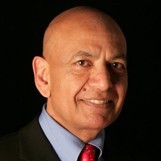Dr. Anil K. Gupta is the Michael D. Dingman Chair in Strategy, Globalization and Entrepreneurship and Distinguished Scholar-Teacher at the Smith School of Business, The University of Maryland at College Park. Anil also serves as chairman, The China India Institute, a Washington DC-based research and consulting organization. He is a Distinguished Visiting Professor at Tsinghua University, China and Indian Institute of Technology, Bombay and has earlier served as a Chaired Professor in Strategy at INSEAD and a visiting professor at Stanford University and Dartmouth College. He received a doctorate from the Harvard Business School, an M.B.A. from the Indian Institute of Management at Ahmedabad, and a B.Tech. from the Indian Institute of Technology at Kanpur.
Anil is widely regarded as one of the world’s leading experts on strategy, globalization and entrepreneurship. Ranked by Thinkers50 as one of the “world’s most influential management thinkers,” he has also been named by The Economist as one of the world’s “superstars” for research on emerging markets in a cover story on “Innovation in Emerging Economies.” He is one of only 3 professors in the world to have been elected by his peers as a Lifetime Fellow of all three of the most prestigious bodies in the field – Academy of Management, Strategic Management Society, and Academy of International Business, with a combined membership of over 25,000 scholars worldwide. . He is also the recipient of the 2017 Outstanding Educator Award from the Academy of Management for worldwide contribution to research, practice, and teaching on the topic of globalization.
Anil is a member of the World Economic Forum’s Stewardship Committee for the Initiative on the Future of Consumption, the Bretton Woods Committee set up by the World Bank and IMF to advise them on solutions to global challenges, and the CNBC Disruptor 50 Advisory Council. He is a frequent participant at the World Economic Forum’s annual summits in Davos as well as regional summits in China, India, and the Middle East.
Anil’s other honors include the “Best Professor in Strategic Management” award from CMO Asia, recognition by BusinessWeek as an Outstanding Faculty in its Guide to the Best B-Schools, induction into the Academy of Management Journals’ Hall of Fame, and listing by Management International Review as a “North American Superstar” for research in strategy and organization. He is also a regular participant at the World Economic Forum summits including the annual meeting in Davos and the regional meetings in China, India, and the Middle East. He is also a member of the Forum’s Global Agenda Council on Emerging Multinationals.
Anil is the author, coauthor or coeditor of several highly acclaimed books including The Silk Road Rediscovered (Wiley, 2014), Getting China and India Right (Wiley, 2009), Global Strategies for Emerging Asia (Wiley, 2012), The Quest for Global Dominance (Wiley, 2008), Smart Globalization (Wiley, 2003), and Global Strategy and Organization (Wiley, 2003) as well as over 70 papers in leading academic journals. Getting China and India Right received the 2009 Axiom Book Awards’ Silver Prize as one of the world’s two best books on globalization and was short-listed for the Asia Society’s Annual Bernard Schwartz Book Award.
Anil’s opinion pieces have been published in Harvard Business Review, The Wall Street Journal, Financial Times, Chief Executive Magazine, Bloomberg BusinessWeek, Daily Telegraph, China Daily, Economic Times, and other outlets. He has been interviewed by Harvard Business Review, Economist, The Wall Street Journal, The Washington Post, USA Today, Forbes, BBC, CNBC, Bloomberg TV, Reuters TV, as well as other top-tier media.
Anil serves regularly as a speaker at major conferences and corporate forums in the US, Europe, Asia, Latin America, and Africa – including the World Economic Forum, Economist conferences, Chief Executive magazine’s CEO2CEO Summits, and the Yale CEO Summit. He has also served as a consultant, keynote speaker and/or executive education faculty with some of the largest corporations in the world including GE, Wal-Mart, IBM, HSBC, Deutsche Bank, H-P, SAP, Microsoft, Schneider Electric, PPG Industries, Accenture, Marriott, First Data, Jacobs, ABB, Lockheed Martin, Indian Oil, Huawei, TeliaSonera, Metso, UPM-Kymmene, Cemex, and others.
Anil is a Charter Member of TiE-DC, the premier organization of VCs and technology entrepreneurs in the US Mid-Atlantic Region. He is also an Advisor at Bangalore-based Kstart (one of the most prestigious technology incubators in India), the E-Ship Centre at IIT Bombay, and Asia Silicon Valley Connection. He has earlier served as an elected board member for several companies including Origene Technologies (a VC-backed gene cloning company), Omega (NASDAQ), Vitalink (NYSE), and NeoMagic (NASDAQ) and as an Advisor to the US-India Business Council.











